Case Study Analysis: Leadership and Management in the NHS
VerifiedAdded on 2023/01/19
|11
|2685
|29
Case Study
AI Summary
This case study report examines key aspects of leadership and management within the National Health Service (NHS). It explores various leadership models such as autocratic, democratic, and situational leadership, and analyzes the application of management theories, including Fayol's principles, within the NHS context. The report highlights the importance of training and development, utilizing the ADDIE model to improve workforce performance, and emphasizes the role of talent management in enhancing employee motivation and retention. It provides recommendations for the NHS to adopt a combination of leadership styles, evaluate employee skill sets, and implement effective talent management strategies to address current and future challenges. This comprehensive analysis covers leadership, management, training, and talent management in the NHS.

CASE STUDY PORTFOLIO
Paraphrase This Document
Need a fresh take? Get an instant paraphrase of this document with our AI Paraphraser
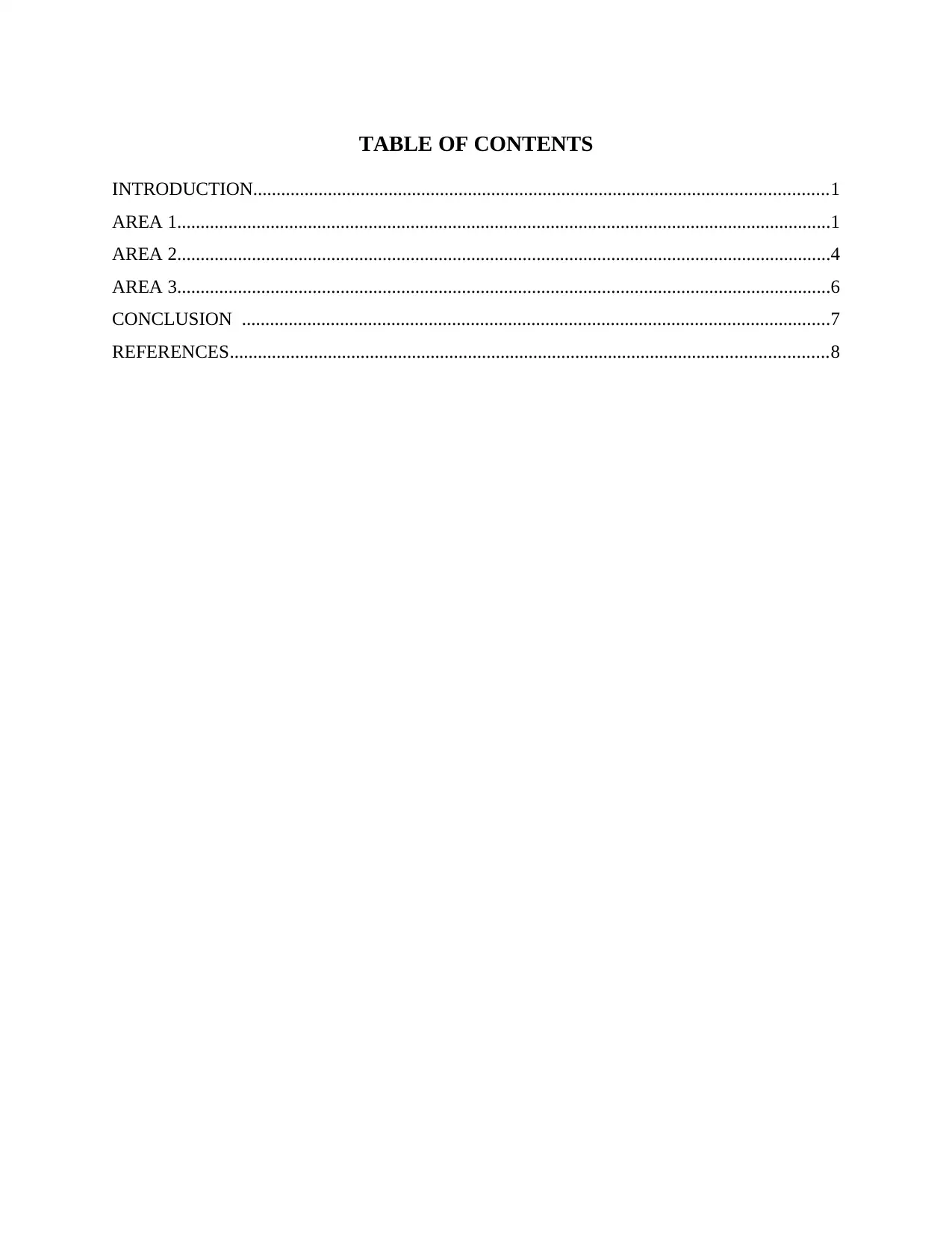
TABLE OF CONTENTS
INTRODUCTION...........................................................................................................................1
AREA 1............................................................................................................................................1
AREA 2............................................................................................................................................4
AREA 3............................................................................................................................................6
CONCLUSION ..............................................................................................................................7
REFERENCES................................................................................................................................8
INTRODUCTION...........................................................................................................................1
AREA 1............................................................................................................................................1
AREA 2............................................................................................................................................4
AREA 3............................................................................................................................................6
CONCLUSION ..............................................................................................................................7
REFERENCES................................................................................................................................8
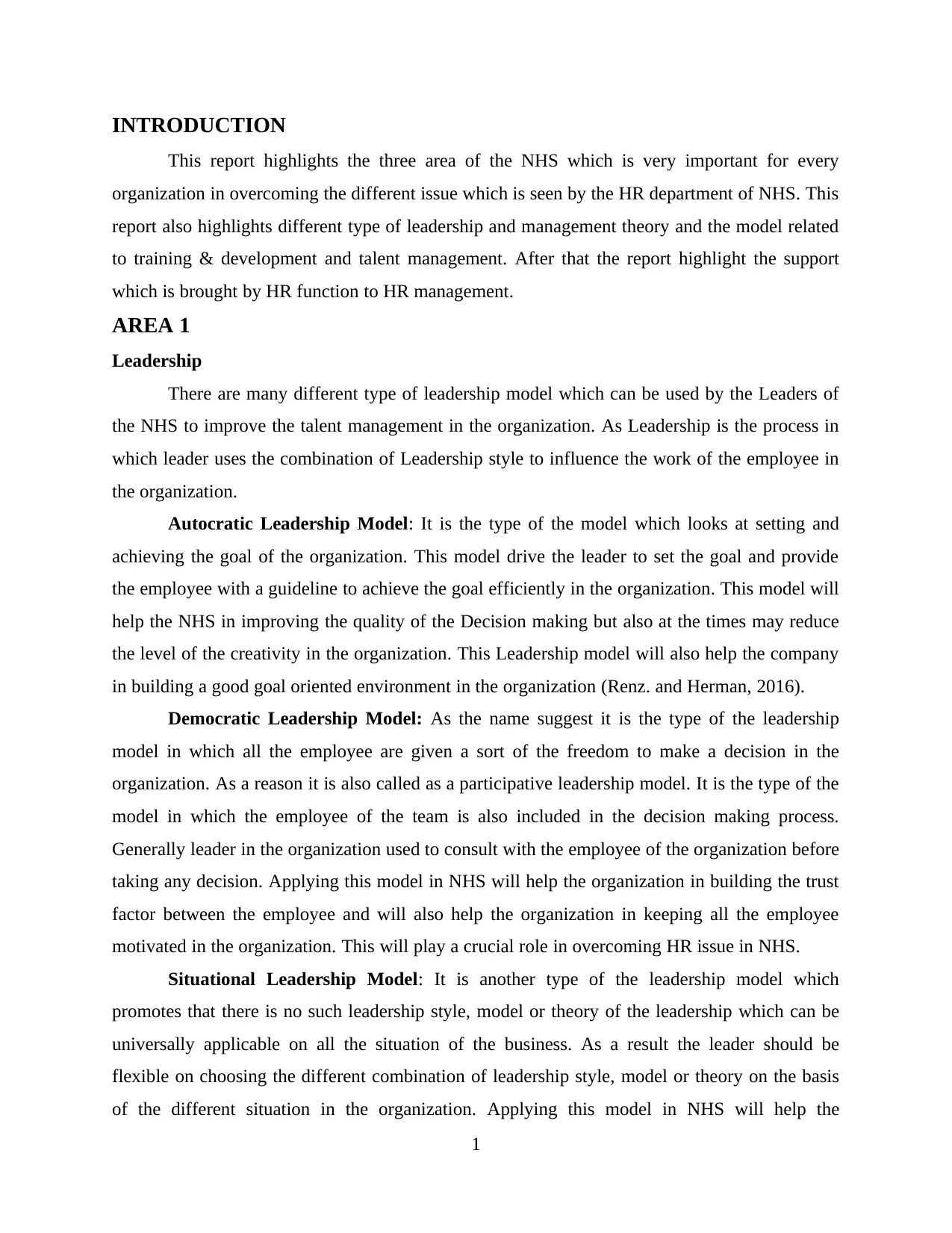
INTRODUCTION
This report highlights the three area of the NHS which is very important for every
organization in overcoming the different issue which is seen by the HR department of NHS. This
report also highlights different type of leadership and management theory and the model related
to training & development and talent management. After that the report highlight the support
which is brought by HR function to HR management.
AREA 1
Leadership
There are many different type of leadership model which can be used by the Leaders of
the NHS to improve the talent management in the organization. As Leadership is the process in
which leader uses the combination of Leadership style to influence the work of the employee in
the organization.
Autocratic Leadership Model: It is the type of the model which looks at setting and
achieving the goal of the organization. This model drive the leader to set the goal and provide
the employee with a guideline to achieve the goal efficiently in the organization. This model will
help the NHS in improving the quality of the Decision making but also at the times may reduce
the level of the creativity in the organization. This Leadership model will also help the company
in building a good goal oriented environment in the organization (Renz. and Herman, 2016).
Democratic Leadership Model: As the name suggest it is the type of the leadership
model in which all the employee are given a sort of the freedom to make a decision in the
organization. As a reason it is also called as a participative leadership model. It is the type of the
model in which the employee of the team is also included in the decision making process.
Generally leader in the organization used to consult with the employee of the organization before
taking any decision. Applying this model in NHS will help the organization in building the trust
factor between the employee and will also help the organization in keeping all the employee
motivated in the organization. This will play a crucial role in overcoming HR issue in NHS.
Situational Leadership Model: It is another type of the leadership model which
promotes that there is no such leadership style, model or theory of the leadership which can be
universally applicable on all the situation of the business. As a result the leader should be
flexible on choosing the different combination of leadership style, model or theory on the basis
of the different situation in the organization. Applying this model in NHS will help the
1
This report highlights the three area of the NHS which is very important for every
organization in overcoming the different issue which is seen by the HR department of NHS. This
report also highlights different type of leadership and management theory and the model related
to training & development and talent management. After that the report highlight the support
which is brought by HR function to HR management.
AREA 1
Leadership
There are many different type of leadership model which can be used by the Leaders of
the NHS to improve the talent management in the organization. As Leadership is the process in
which leader uses the combination of Leadership style to influence the work of the employee in
the organization.
Autocratic Leadership Model: It is the type of the model which looks at setting and
achieving the goal of the organization. This model drive the leader to set the goal and provide
the employee with a guideline to achieve the goal efficiently in the organization. This model will
help the NHS in improving the quality of the Decision making but also at the times may reduce
the level of the creativity in the organization. This Leadership model will also help the company
in building a good goal oriented environment in the organization (Renz. and Herman, 2016).
Democratic Leadership Model: As the name suggest it is the type of the leadership
model in which all the employee are given a sort of the freedom to make a decision in the
organization. As a reason it is also called as a participative leadership model. It is the type of the
model in which the employee of the team is also included in the decision making process.
Generally leader in the organization used to consult with the employee of the organization before
taking any decision. Applying this model in NHS will help the organization in building the trust
factor between the employee and will also help the organization in keeping all the employee
motivated in the organization. This will play a crucial role in overcoming HR issue in NHS.
Situational Leadership Model: It is another type of the leadership model which
promotes that there is no such leadership style, model or theory of the leadership which can be
universally applicable on all the situation of the business. As a result the leader should be
flexible on choosing the different combination of leadership style, model or theory on the basis
of the different situation in the organization. Applying this model in NHS will help the
1
⊘ This is a preview!⊘
Do you want full access?
Subscribe today to unlock all pages.

Trusted by 1+ million students worldwide
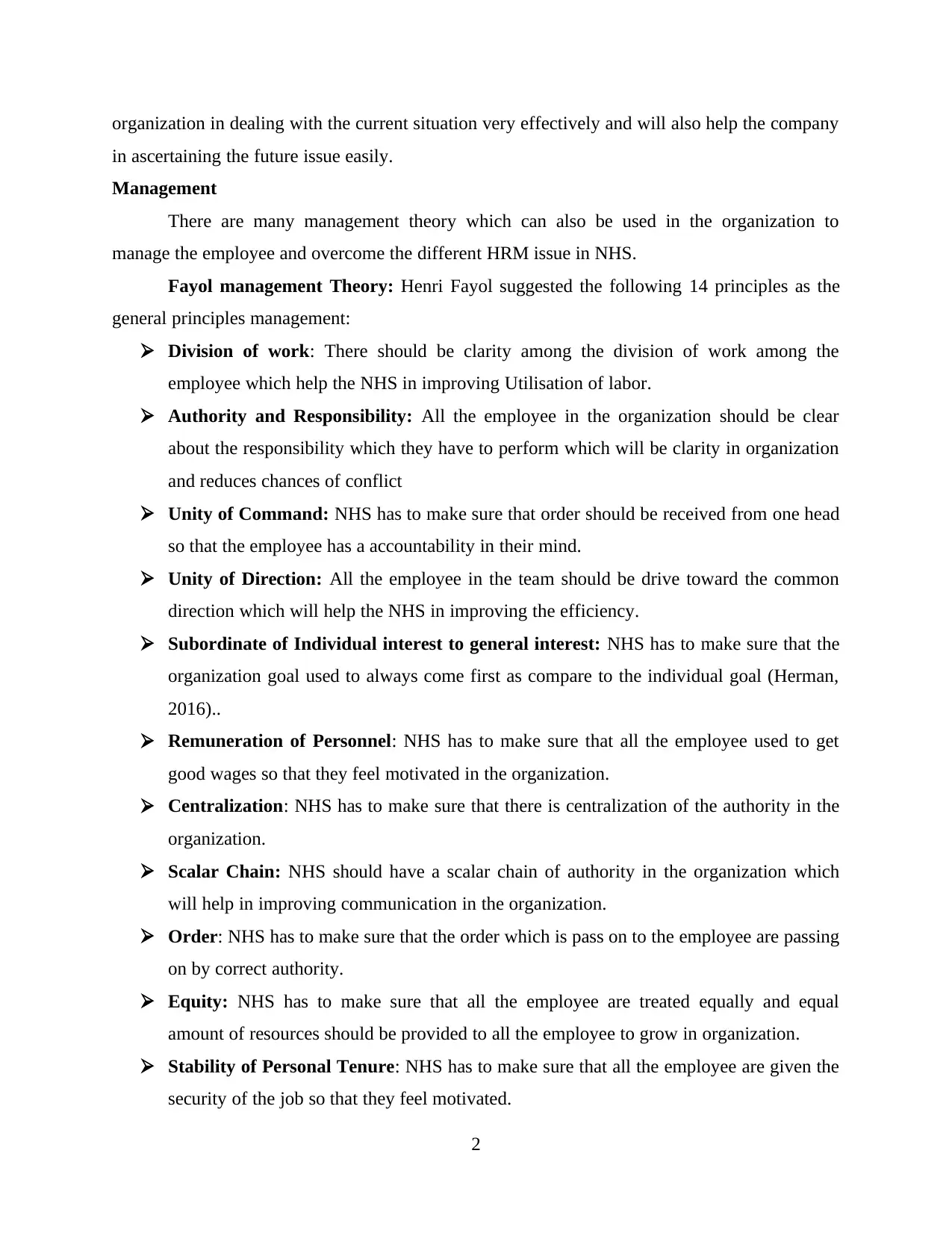
organization in dealing with the current situation very effectively and will also help the company
in ascertaining the future issue easily.
Management
There are many management theory which can also be used in the organization to
manage the employee and overcome the different HRM issue in NHS.
Fayol management Theory: Henri Fayol suggested the following 14 principles as the
general principles management:
Division of work: There should be clarity among the division of work among the
employee which help the NHS in improving Utilisation of labor.
Authority and Responsibility: All the employee in the organization should be clear
about the responsibility which they have to perform which will be clarity in organization
and reduces chances of conflict
Unity of Command: NHS has to make sure that order should be received from one head
so that the employee has a accountability in their mind.
Unity of Direction: All the employee in the team should be drive toward the common
direction which will help the NHS in improving the efficiency.
Subordinate of Individual interest to general interest: NHS has to make sure that the
organization goal used to always come first as compare to the individual goal (Herman,
2016)..
Remuneration of Personnel: NHS has to make sure that all the employee used to get
good wages so that they feel motivated in the organization.
Centralization: NHS has to make sure that there is centralization of the authority in the
organization.
Scalar Chain: NHS should have a scalar chain of authority in the organization which
will help in improving communication in the organization.
Order: NHS has to make sure that the order which is pass on to the employee are passing
on by correct authority.
Equity: NHS has to make sure that all the employee are treated equally and equal
amount of resources should be provided to all the employee to grow in organization.
Stability of Personal Tenure: NHS has to make sure that all the employee are given the
security of the job so that they feel motivated.
2
in ascertaining the future issue easily.
Management
There are many management theory which can also be used in the organization to
manage the employee and overcome the different HRM issue in NHS.
Fayol management Theory: Henri Fayol suggested the following 14 principles as the
general principles management:
Division of work: There should be clarity among the division of work among the
employee which help the NHS in improving Utilisation of labor.
Authority and Responsibility: All the employee in the organization should be clear
about the responsibility which they have to perform which will be clarity in organization
and reduces chances of conflict
Unity of Command: NHS has to make sure that order should be received from one head
so that the employee has a accountability in their mind.
Unity of Direction: All the employee in the team should be drive toward the common
direction which will help the NHS in improving the efficiency.
Subordinate of Individual interest to general interest: NHS has to make sure that the
organization goal used to always come first as compare to the individual goal (Herman,
2016)..
Remuneration of Personnel: NHS has to make sure that all the employee used to get
good wages so that they feel motivated in the organization.
Centralization: NHS has to make sure that there is centralization of the authority in the
organization.
Scalar Chain: NHS should have a scalar chain of authority in the organization which
will help in improving communication in the organization.
Order: NHS has to make sure that the order which is pass on to the employee are passing
on by correct authority.
Equity: NHS has to make sure that all the employee are treated equally and equal
amount of resources should be provided to all the employee to grow in organization.
Stability of Personal Tenure: NHS has to make sure that all the employee are given the
security of the job so that they feel motivated.
2
Paraphrase This Document
Need a fresh take? Get an instant paraphrase of this document with our AI Paraphraser
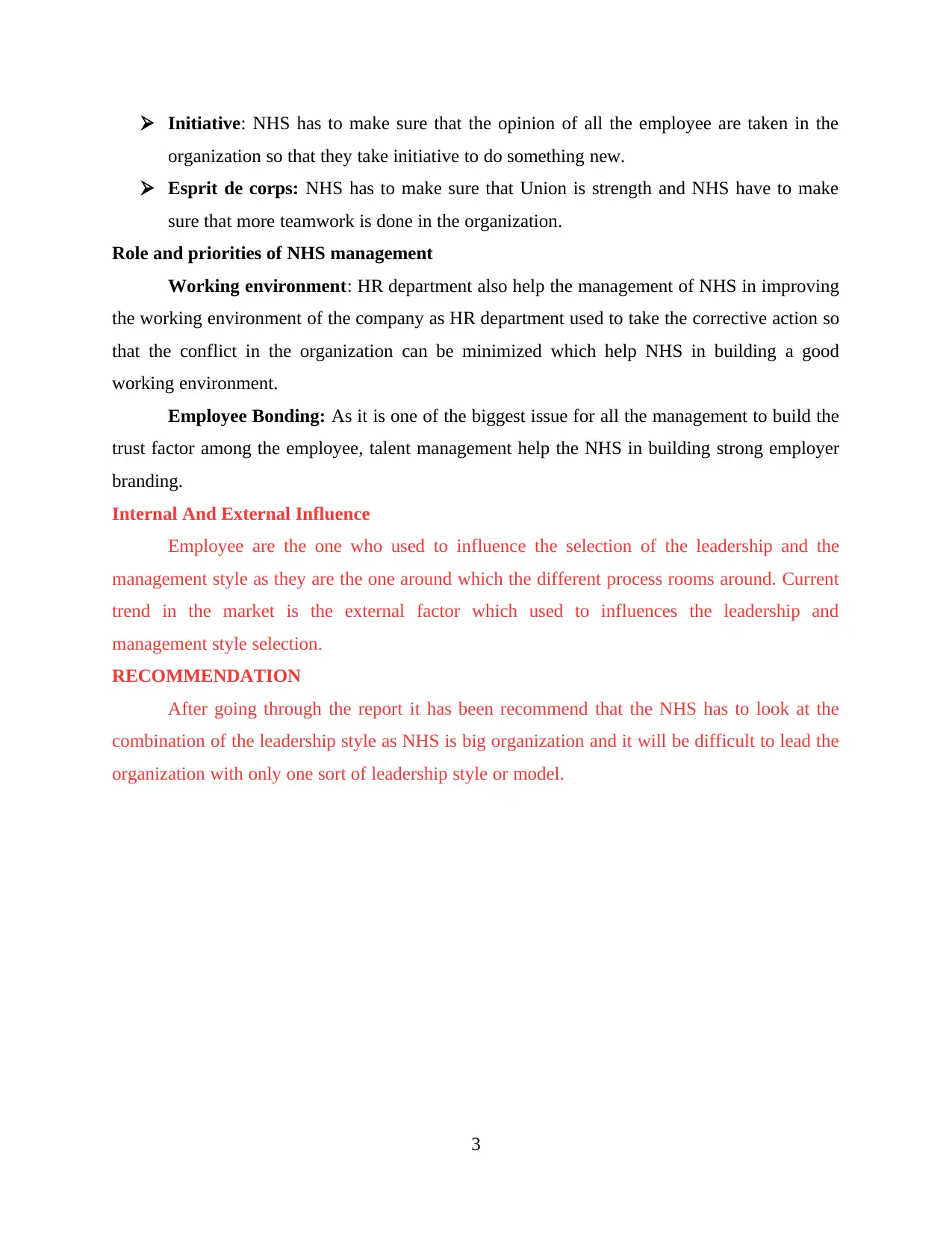
Initiative: NHS has to make sure that the opinion of all the employee are taken in the
organization so that they take initiative to do something new.
Esprit de corps: NHS has to make sure that Union is strength and NHS have to make
sure that more teamwork is done in the organization.
Role and priorities of NHS management
Working environment: HR department also help the management of NHS in improving
the working environment of the company as HR department used to take the corrective action so
that the conflict in the organization can be minimized which help NHS in building a good
working environment.
Employee Bonding: As it is one of the biggest issue for all the management to build the
trust factor among the employee, talent management help the NHS in building strong employer
branding.
Internal And External Influence
Employee are the one who used to influence the selection of the leadership and the
management style as they are the one around which the different process rooms around. Current
trend in the market is the external factor which used to influences the leadership and
management style selection.
RECOMMENDATION
After going through the report it has been recommend that the NHS has to look at the
combination of the leadership style as NHS is big organization and it will be difficult to lead the
organization with only one sort of leadership style or model.
3
organization so that they take initiative to do something new.
Esprit de corps: NHS has to make sure that Union is strength and NHS have to make
sure that more teamwork is done in the organization.
Role and priorities of NHS management
Working environment: HR department also help the management of NHS in improving
the working environment of the company as HR department used to take the corrective action so
that the conflict in the organization can be minimized which help NHS in building a good
working environment.
Employee Bonding: As it is one of the biggest issue for all the management to build the
trust factor among the employee, talent management help the NHS in building strong employer
branding.
Internal And External Influence
Employee are the one who used to influence the selection of the leadership and the
management style as they are the one around which the different process rooms around. Current
trend in the market is the external factor which used to influences the leadership and
management style selection.
RECOMMENDATION
After going through the report it has been recommend that the NHS has to look at the
combination of the leadership style as NHS is big organization and it will be difficult to lead the
organization with only one sort of leadership style or model.
3
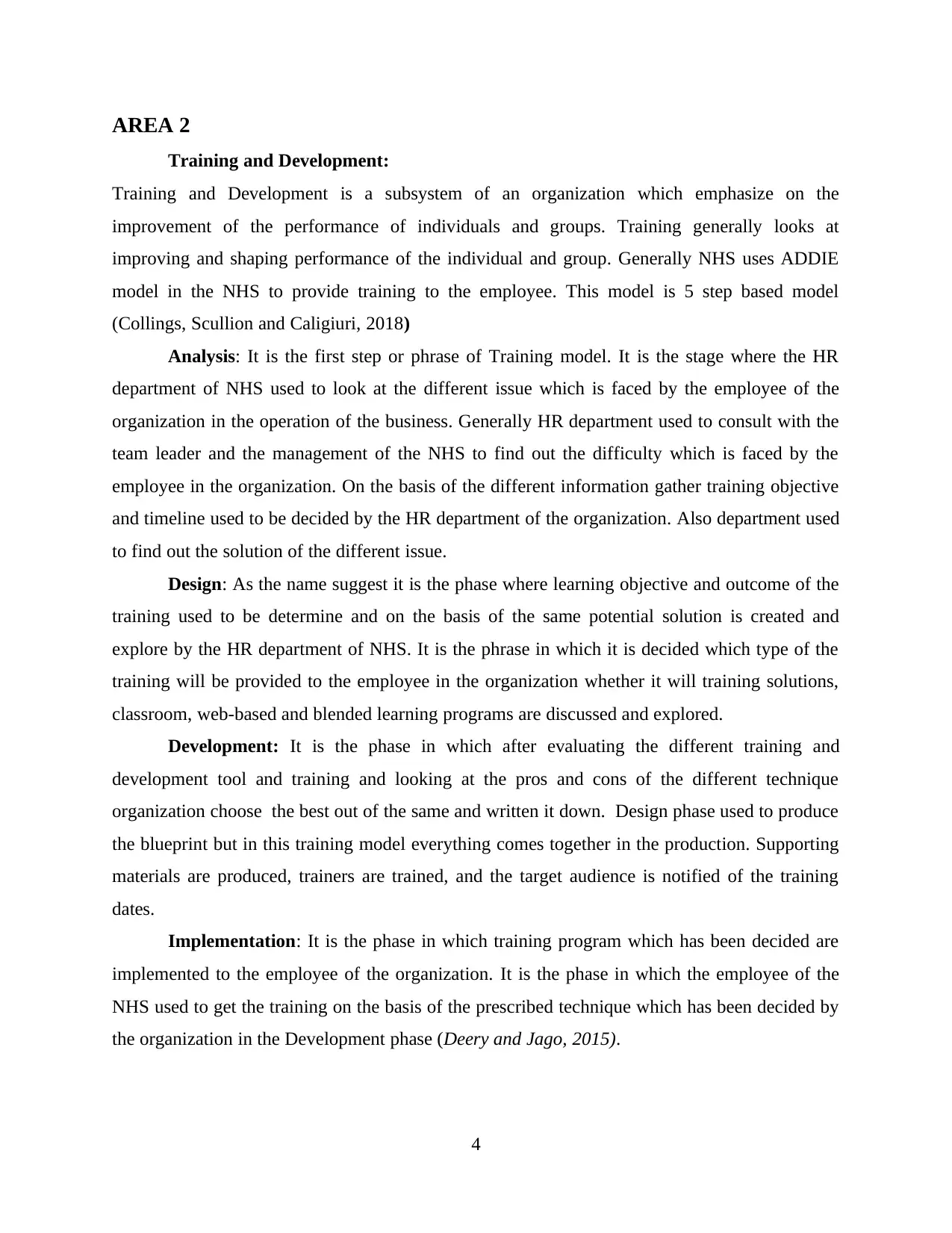
AREA 2
Training and Development:
Training and Development is a subsystem of an organization which emphasize on the
improvement of the performance of individuals and groups. Training generally looks at
improving and shaping performance of the individual and group. Generally NHS uses ADDIE
model in the NHS to provide training to the employee. This model is 5 step based model
(Collings, Scullion and Caligiuri, 2018)
Analysis: It is the first step or phrase of Training model. It is the stage where the HR
department of NHS used to look at the different issue which is faced by the employee of the
organization in the operation of the business. Generally HR department used to consult with the
team leader and the management of the NHS to find out the difficulty which is faced by the
employee in the organization. On the basis of the different information gather training objective
and timeline used to be decided by the HR department of the organization. Also department used
to find out the solution of the different issue.
Design: As the name suggest it is the phase where learning objective and outcome of the
training used to be determine and on the basis of the same potential solution is created and
explore by the HR department of NHS. It is the phrase in which it is decided which type of the
training will be provided to the employee in the organization whether it will training solutions,
classroom, web-based and blended learning programs are discussed and explored.
Development: It is the phase in which after evaluating the different training and
development tool and training and looking at the pros and cons of the different technique
organization choose the best out of the same and written it down. Design phase used to produce
the blueprint but in this training model everything comes together in the production. Supporting
materials are produced, trainers are trained, and the target audience is notified of the training
dates.
Implementation: It is the phase in which training program which has been decided are
implemented to the employee of the organization. It is the phase in which the employee of the
NHS used to get the training on the basis of the prescribed technique which has been decided by
the organization in the Development phase (Deery and Jago, 2015).
4
Training and Development:
Training and Development is a subsystem of an organization which emphasize on the
improvement of the performance of individuals and groups. Training generally looks at
improving and shaping performance of the individual and group. Generally NHS uses ADDIE
model in the NHS to provide training to the employee. This model is 5 step based model
(Collings, Scullion and Caligiuri, 2018)
Analysis: It is the first step or phrase of Training model. It is the stage where the HR
department of NHS used to look at the different issue which is faced by the employee of the
organization in the operation of the business. Generally HR department used to consult with the
team leader and the management of the NHS to find out the difficulty which is faced by the
employee in the organization. On the basis of the different information gather training objective
and timeline used to be decided by the HR department of the organization. Also department used
to find out the solution of the different issue.
Design: As the name suggest it is the phase where learning objective and outcome of the
training used to be determine and on the basis of the same potential solution is created and
explore by the HR department of NHS. It is the phrase in which it is decided which type of the
training will be provided to the employee in the organization whether it will training solutions,
classroom, web-based and blended learning programs are discussed and explored.
Development: It is the phase in which after evaluating the different training and
development tool and training and looking at the pros and cons of the different technique
organization choose the best out of the same and written it down. Design phase used to produce
the blueprint but in this training model everything comes together in the production. Supporting
materials are produced, trainers are trained, and the target audience is notified of the training
dates.
Implementation: It is the phase in which training program which has been decided are
implemented to the employee of the organization. It is the phase in which the employee of the
NHS used to get the training on the basis of the prescribed technique which has been decided by
the organization in the Development phase (Deery and Jago, 2015).
4
⊘ This is a preview!⊘
Do you want full access?
Subscribe today to unlock all pages.

Trusted by 1+ million students worldwide
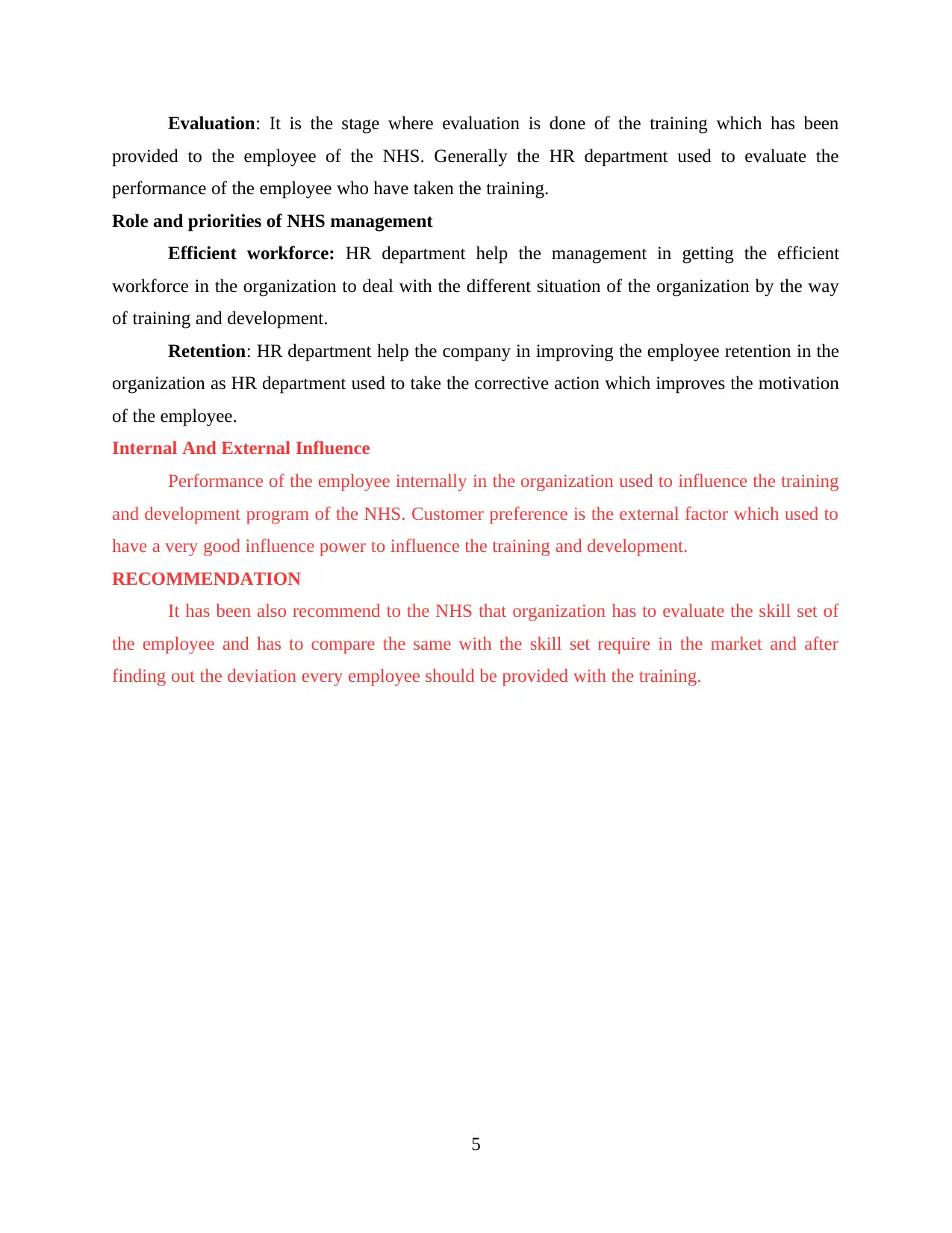
Evaluation: It is the stage where evaluation is done of the training which has been
provided to the employee of the NHS. Generally the HR department used to evaluate the
performance of the employee who have taken the training.
Role and priorities of NHS management
Efficient workforce: HR department help the management in getting the efficient
workforce in the organization to deal with the different situation of the organization by the way
of training and development.
Retention: HR department help the company in improving the employee retention in the
organization as HR department used to take the corrective action which improves the motivation
of the employee.
Internal And External Influence
Performance of the employee internally in the organization used to influence the training
and development program of the NHS. Customer preference is the external factor which used to
have a very good influence power to influence the training and development.
RECOMMENDATION
It has been also recommend to the NHS that organization has to evaluate the skill set of
the employee and has to compare the same with the skill set require in the market and after
finding out the deviation every employee should be provided with the training.
5
provided to the employee of the NHS. Generally the HR department used to evaluate the
performance of the employee who have taken the training.
Role and priorities of NHS management
Efficient workforce: HR department help the management in getting the efficient
workforce in the organization to deal with the different situation of the organization by the way
of training and development.
Retention: HR department help the company in improving the employee retention in the
organization as HR department used to take the corrective action which improves the motivation
of the employee.
Internal And External Influence
Performance of the employee internally in the organization used to influence the training
and development program of the NHS. Customer preference is the external factor which used to
have a very good influence power to influence the training and development.
RECOMMENDATION
It has been also recommend to the NHS that organization has to evaluate the skill set of
the employee and has to compare the same with the skill set require in the market and after
finding out the deviation every employee should be provided with the training.
5
Paraphrase This Document
Need a fresh take? Get an instant paraphrase of this document with our AI Paraphraser
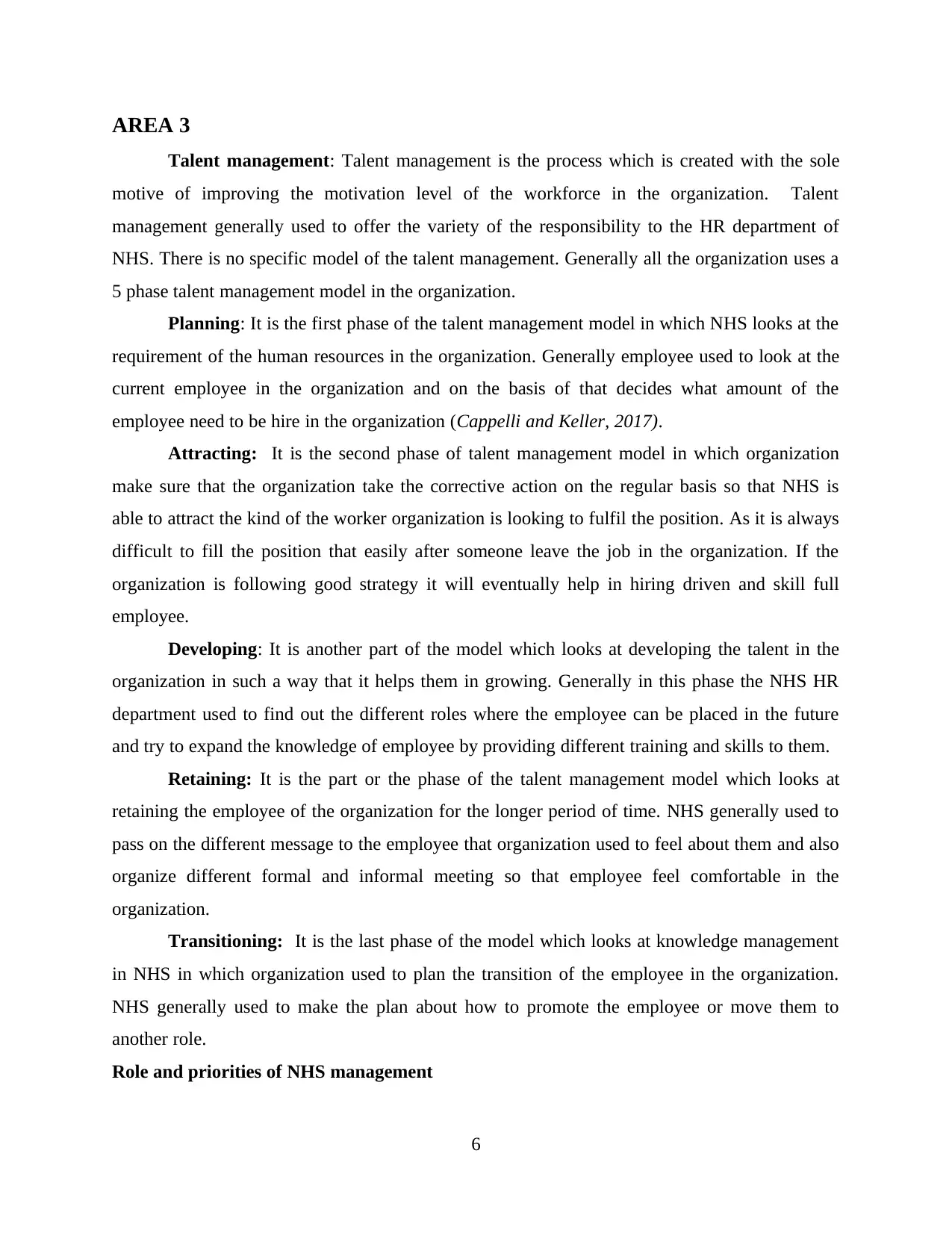
AREA 3
Talent management: Talent management is the process which is created with the sole
motive of improving the motivation level of the workforce in the organization. Talent
management generally used to offer the variety of the responsibility to the HR department of
NHS. There is no specific model of the talent management. Generally all the organization uses a
5 phase talent management model in the organization.
Planning: It is the first phase of the talent management model in which NHS looks at the
requirement of the human resources in the organization. Generally employee used to look at the
current employee in the organization and on the basis of that decides what amount of the
employee need to be hire in the organization (Cappelli and Keller, 2017).
Attracting: It is the second phase of talent management model in which organization
make sure that the organization take the corrective action on the regular basis so that NHS is
able to attract the kind of the worker organization is looking to fulfil the position. As it is always
difficult to fill the position that easily after someone leave the job in the organization. If the
organization is following good strategy it will eventually help in hiring driven and skill full
employee.
Developing: It is another part of the model which looks at developing the talent in the
organization in such a way that it helps them in growing. Generally in this phase the NHS HR
department used to find out the different roles where the employee can be placed in the future
and try to expand the knowledge of employee by providing different training and skills to them.
Retaining: It is the part or the phase of the talent management model which looks at
retaining the employee of the organization for the longer period of time. NHS generally used to
pass on the different message to the employee that organization used to feel about them and also
organize different formal and informal meeting so that employee feel comfortable in the
organization.
Transitioning: It is the last phase of the model which looks at knowledge management
in NHS in which organization used to plan the transition of the employee in the organization.
NHS generally used to make the plan about how to promote the employee or move them to
another role.
Role and priorities of NHS management
6
Talent management: Talent management is the process which is created with the sole
motive of improving the motivation level of the workforce in the organization. Talent
management generally used to offer the variety of the responsibility to the HR department of
NHS. There is no specific model of the talent management. Generally all the organization uses a
5 phase talent management model in the organization.
Planning: It is the first phase of the talent management model in which NHS looks at the
requirement of the human resources in the organization. Generally employee used to look at the
current employee in the organization and on the basis of that decides what amount of the
employee need to be hire in the organization (Cappelli and Keller, 2017).
Attracting: It is the second phase of talent management model in which organization
make sure that the organization take the corrective action on the regular basis so that NHS is
able to attract the kind of the worker organization is looking to fulfil the position. As it is always
difficult to fill the position that easily after someone leave the job in the organization. If the
organization is following good strategy it will eventually help in hiring driven and skill full
employee.
Developing: It is another part of the model which looks at developing the talent in the
organization in such a way that it helps them in growing. Generally in this phase the NHS HR
department used to find out the different roles where the employee can be placed in the future
and try to expand the knowledge of employee by providing different training and skills to them.
Retaining: It is the part or the phase of the talent management model which looks at
retaining the employee of the organization for the longer period of time. NHS generally used to
pass on the different message to the employee that organization used to feel about them and also
organize different formal and informal meeting so that employee feel comfortable in the
organization.
Transitioning: It is the last phase of the model which looks at knowledge management
in NHS in which organization used to plan the transition of the employee in the organization.
NHS generally used to make the plan about how to promote the employee or move them to
another role.
Role and priorities of NHS management
6
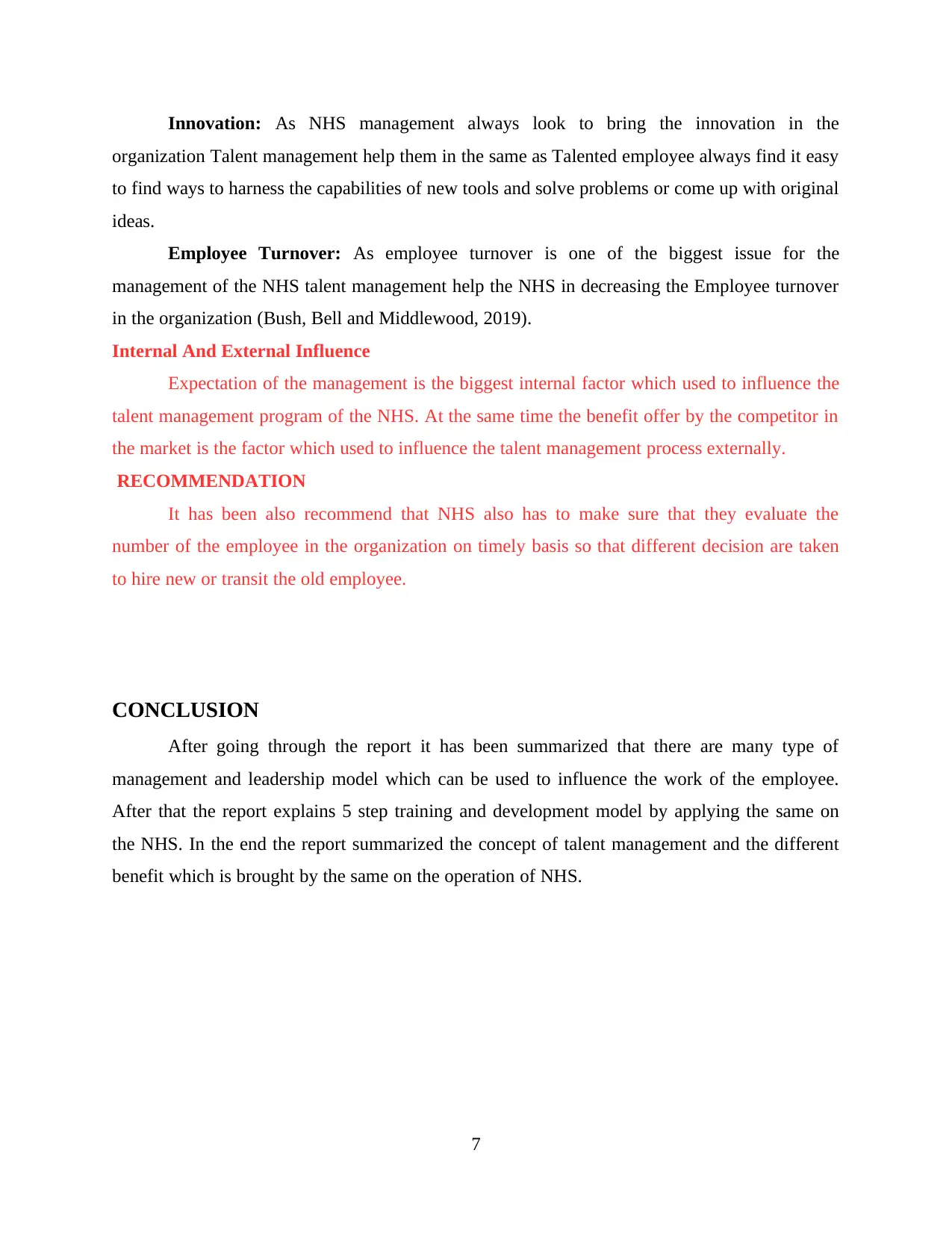
Innovation: As NHS management always look to bring the innovation in the
organization Talent management help them in the same as Talented employee always find it easy
to find ways to harness the capabilities of new tools and solve problems or come up with original
ideas.
Employee Turnover: As employee turnover is one of the biggest issue for the
management of the NHS talent management help the NHS in decreasing the Employee turnover
in the organization (Bush, Bell and Middlewood, 2019).
Internal And External Influence
Expectation of the management is the biggest internal factor which used to influence the
talent management program of the NHS. At the same time the benefit offer by the competitor in
the market is the factor which used to influence the talent management process externally.
RECOMMENDATION
It has been also recommend that NHS also has to make sure that they evaluate the
number of the employee in the organization on timely basis so that different decision are taken
to hire new or transit the old employee.
CONCLUSION
After going through the report it has been summarized that there are many type of
management and leadership model which can be used to influence the work of the employee.
After that the report explains 5 step training and development model by applying the same on
the NHS. In the end the report summarized the concept of talent management and the different
benefit which is brought by the same on the operation of NHS.
7
organization Talent management help them in the same as Talented employee always find it easy
to find ways to harness the capabilities of new tools and solve problems or come up with original
ideas.
Employee Turnover: As employee turnover is one of the biggest issue for the
management of the NHS talent management help the NHS in decreasing the Employee turnover
in the organization (Bush, Bell and Middlewood, 2019).
Internal And External Influence
Expectation of the management is the biggest internal factor which used to influence the
talent management program of the NHS. At the same time the benefit offer by the competitor in
the market is the factor which used to influence the talent management process externally.
RECOMMENDATION
It has been also recommend that NHS also has to make sure that they evaluate the
number of the employee in the organization on timely basis so that different decision are taken
to hire new or transit the old employee.
CONCLUSION
After going through the report it has been summarized that there are many type of
management and leadership model which can be used to influence the work of the employee.
After that the report explains 5 step training and development model by applying the same on
the NHS. In the end the report summarized the concept of talent management and the different
benefit which is brought by the same on the operation of NHS.
7
⊘ This is a preview!⊘
Do you want full access?
Subscribe today to unlock all pages.

Trusted by 1+ million students worldwide
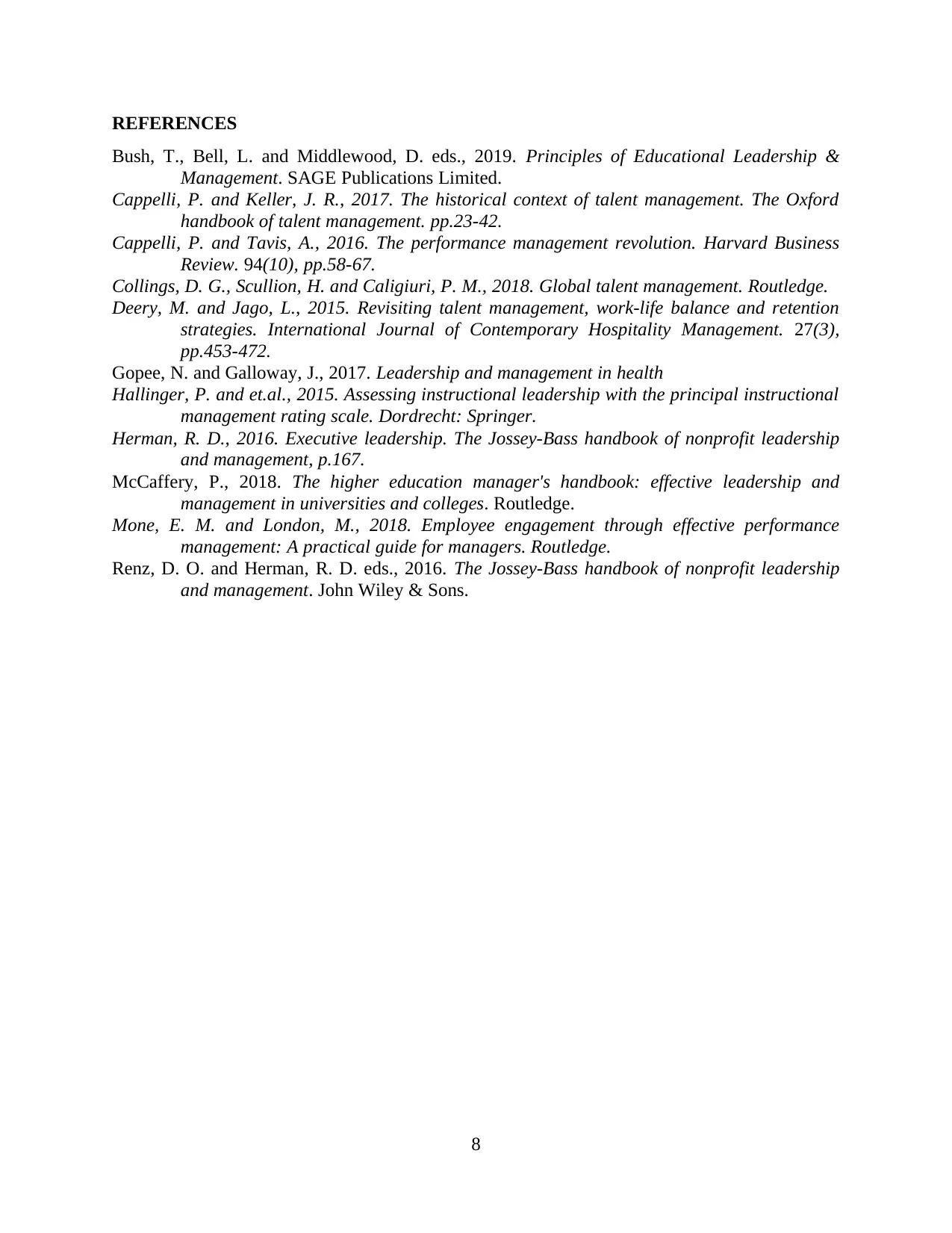
REFERENCES
Bush, T., Bell, L. and Middlewood, D. eds., 2019. Principles of Educational Leadership &
Management. SAGE Publications Limited.
Cappelli, P. and Keller, J. R., 2017. The historical context of talent management. The Oxford
handbook of talent management. pp.23-42.
Cappelli, P. and Tavis, A., 2016. The performance management revolution. Harvard Business
Review. 94(10), pp.58-67.
Collings, D. G., Scullion, H. and Caligiuri, P. M., 2018. Global talent management. Routledge.
Deery, M. and Jago, L., 2015. Revisiting talent management, work-life balance and retention
strategies. International Journal of Contemporary Hospitality Management. 27(3),
pp.453-472.
Gopee, N. and Galloway, J., 2017. Leadership and management in health
Hallinger, P. and et.al., 2015. Assessing instructional leadership with the principal instructional
management rating scale. Dordrecht: Springer.
Herman, R. D., 2016. Executive leadership. The Jossey-Bass handbook of nonprofit leadership
and management, p.167.
McCaffery, P., 2018. The higher education manager's handbook: effective leadership and
management in universities and colleges. Routledge.
Mone, E. M. and London, M., 2018. Employee engagement through effective performance
management: A practical guide for managers. Routledge.
Renz, D. O. and Herman, R. D. eds., 2016. The Jossey-Bass handbook of nonprofit leadership
and management. John Wiley & Sons.
8
Bush, T., Bell, L. and Middlewood, D. eds., 2019. Principles of Educational Leadership &
Management. SAGE Publications Limited.
Cappelli, P. and Keller, J. R., 2017. The historical context of talent management. The Oxford
handbook of talent management. pp.23-42.
Cappelli, P. and Tavis, A., 2016. The performance management revolution. Harvard Business
Review. 94(10), pp.58-67.
Collings, D. G., Scullion, H. and Caligiuri, P. M., 2018. Global talent management. Routledge.
Deery, M. and Jago, L., 2015. Revisiting talent management, work-life balance and retention
strategies. International Journal of Contemporary Hospitality Management. 27(3),
pp.453-472.
Gopee, N. and Galloway, J., 2017. Leadership and management in health
Hallinger, P. and et.al., 2015. Assessing instructional leadership with the principal instructional
management rating scale. Dordrecht: Springer.
Herman, R. D., 2016. Executive leadership. The Jossey-Bass handbook of nonprofit leadership
and management, p.167.
McCaffery, P., 2018. The higher education manager's handbook: effective leadership and
management in universities and colleges. Routledge.
Mone, E. M. and London, M., 2018. Employee engagement through effective performance
management: A practical guide for managers. Routledge.
Renz, D. O. and Herman, R. D. eds., 2016. The Jossey-Bass handbook of nonprofit leadership
and management. John Wiley & Sons.
8
Paraphrase This Document
Need a fresh take? Get an instant paraphrase of this document with our AI Paraphraser

9
1 out of 11
Related Documents
Your All-in-One AI-Powered Toolkit for Academic Success.
+13062052269
info@desklib.com
Available 24*7 on WhatsApp / Email
![[object Object]](/_next/static/media/star-bottom.7253800d.svg)
Unlock your academic potential
Copyright © 2020–2025 A2Z Services. All Rights Reserved. Developed and managed by ZUCOL.





